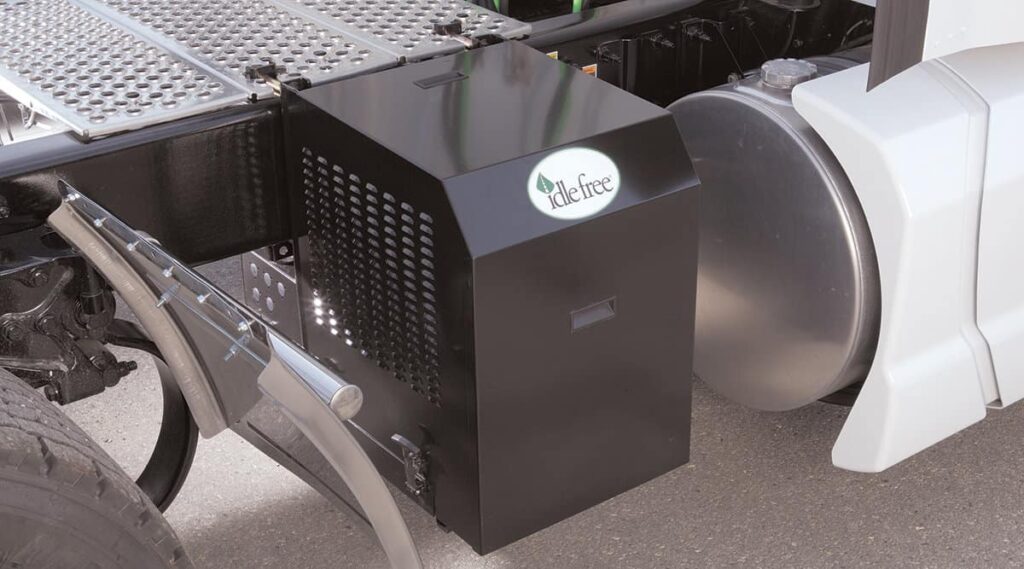Are you tired of feeling like you’re burning money while idling your semi-truck engine? Do you want to reduce your carbon footprint and save on fuel costs? Look no further than an auxiliary power unit (APU). APUs are becoming increasingly popular among truck drivers, and for good reason.
Not only do they save on fuel costs, but they also enhance a driver’s comfort, safety, and overall wellbeing. An APU is a small engine that is installed in a semi-truck to provide power to electrical appliances in the cab and to circulate coolant to heat the cab and engine in cold temperatures. By using an APU instead of idling the main engine, truck drivers can save up to 1 gallon of fuel per hour, resulting in significant cost savings over time.
In addition to the financial benefits, APUs also help reduce harmful greenhouse gas emissions, making them a more environmentally-friendly option. In this article, we will explore the benefits of APUs, compare the costs of using an APU versus idling the main engine, and discuss the importance of APUs for driver wellbeing.
Benefits of an APU
The installation of an APU provides numerous benefits for semi-truck drivers, including increased fuel efficiency, reduced greenhouse gas emissions, improved comfort, and enhanced safety.
One of the main benefits of an APU is its ability to reduce emissions and fuel usage. An APU burns significantly less fuel than idling a truck engine, which can save drivers thousands of dollars in fuel costs each year. In addition to saving money, drivers can reduce their carbon footprint by using an APU, as they emit far fewer GHGs when they run compared to idling a truck engine.
Furthermore, an APU can provide a comfortable and safe environment for truck drivers while they rest. APUs are plumbed into the truck’s cooling system and circulate the coolant to heat the cab and keep the engine warm in cold temperatures to allow for easier starting. This means that drivers can sleep in a warm and comfortable environment, reducing the risk of drowsy driving.
Additionally, APUs power electrical appliances in the cab, including lights, air conditioning, TV, microwave, refrigerator, device chargers, and others, which can enhance the overall quality of life for drivers.

Cost Comparison
Comparing the costs of idling a truck engine versus using an APU is like comparing a leaky faucet to a water-efficient showerhead – one wastes resources and money, while the other conserves them.
Although the initial purchase and installation expenses of an APU may seem daunting, the long term savings are substantial. An APU averages 0.25 gallons per hour while idling the truck’s diesel burns 1.25 gallons per hour. The EPA estimates the average truck idles 2,000 hours per year, resulting in a significant amount of fuel waste and unnecessary expenses for the driver.
Investing in an APU can drastically reduce idling time, leading to significant cost savings over time. Additionally, APUs require regular oil and filter changes, as well as annual maintenance inspections to keep them at peak performance.
While these ongoing maintenance costs may seem like a disadvantage, they are ultimately negligible when compared to the savings achieved through reduced fuel consumption. Therefore, the installation and maintenance expenses of an APU are a small price to pay for the long-term financial benefits and environmental advantages they provide.
also read : Rv Generator Guide: Power Up Safely On The Road
Importance for Driver Wellbeing
Investing in an auxiliary power unit (APU) for a semi-truck can significantly improve the overall wellbeing of the driver. The APU can provide safety and comfort from extreme temperatures, reducing the risk of dangerous drowsy driving. The driver can rest better knowing that the APU is circulating the truck’s coolant to warm the engine during cold weather starts, and that the APU is powering the electronic features in the cab. By reducing costly repairs to the truck’s emission control systems, the APU can also save the driver money in the long run.
In addition to driver comfort, the APU also has a positive environmental impact. By burning significantly less fuel than idling a truck engine, the APU emits far fewer greenhouse gases (GHGs) when it runs. This makes it a much better choice for the environment. Furthermore, electric-powered versions of the APU are available, which produce zero emissions. By reducing fuel consumption and GHG emissions, the APU can help drivers feel good about their contribution to the environment while also improving their own comfort and safety.
| Advantages | Disadvantages |
|---|---|
| Provides safety and comfort from extreme temperatures | Initial purchase and installation cost |
| Enhances the quality of sleep for drivers, reducing dangerous drowsy driving | Ongoing maintenance costs |
| Reduces costly repairs to the truck’s emission control systems | |
| Circulates the truck’s coolant to warm the engine during cold weather starts | |
| Can drastically reduce idling | |
| Powers electronic features in the cab |
Frequently Asked Questions
Are there any tax incentives or rebates available for purchasing and installing an APU?
Tax incentives and installation rebates for APUs are available at the federal and state levels. The IRS offers a tax credit of up to 50% of the cost of an APU, while some states offer grants or rebates. Proper documentation and eligibility criteria apply.
Can an APU be used with alternative fuels such as biodiesel or natural gas?
APUs can be used with alternative fuels such as biodiesel and natural gas, but compatibility and integration may vary depending on the specific model. It is important to consult with the manufacturer or a qualified technician to ensure proper usage.
What is the typical lifespan of an APU and how often does it need to be replaced?
The average lifespan of an APU is approximately 5,000 hours or 5 years, with proper maintenance. Replacement frequency depends on usage and maintenance. Regular inspections and oil/filter changes can extend the life of an APU.
Can an APU be used while driving or is it only meant for stationary use?
Mobile APU options are available for use while driving, providing benefits such as reduced fuel consumption and emissions, improved driver comfort, and the ability to power electronic features. Incorporating an APU into a truck can lead to significant cost savings and environmental benefits.
Are there any restrictions or regulations on the use of APUs in certain states or jurisdictions?
There are regulations and compliance standards regarding the use of APUs in certain states and jurisdictions. However, APUs are generally recognized for their environmental impact and efficiency in reducing fuel consumption and emissions while providing comfort and safety for drivers.






